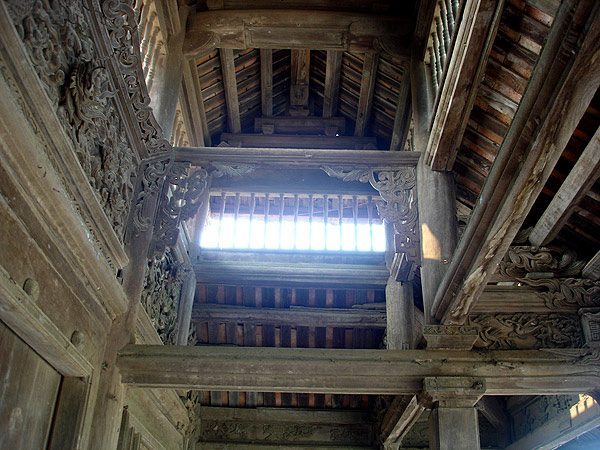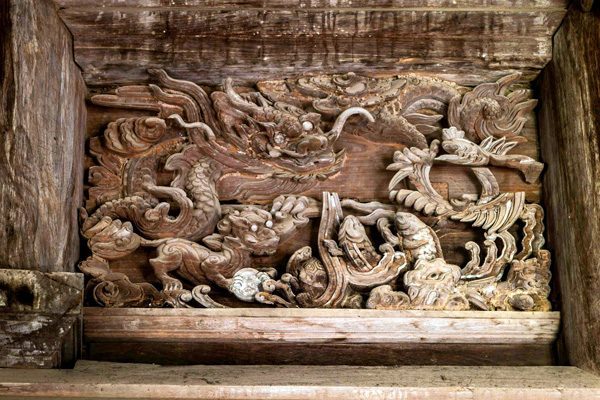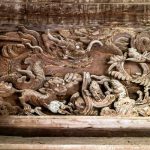HNP- So communal house, located in Cong Hoa commune, Quoc Oai district, about 25km west of Hanoi center, is one of the most beautiful communal houses in Doai’s land ” Beautiful So communal house – Big Can communal house “. The communal house was built in 1673 to worship the three great kings who helped Dinh Tien Hoang – Dinh Bo Linh to defeat 12 warlords.
The communal house is located on a large and high land with the front facing river bank, the back leaning on mountain. In front of the door there is a large semicircular pond that is like a focal point of accumulated prosperity for the villagers. The three-door of So communal house is very beautiful with a flight of stone stairs of 18 steps led to the semicircle lake, two sides of stone railing have a very soft and lively cloud formation on the ends , creating the sensation of the cloud gently dancing in the breeze.
Stepping through the gate into the courtyard, we will reach a feng shui space – decorated in line with the peak of incense, with symmetrical pot plants and pairs of ancient trees. The whole campus of the communal house is surrounded with flower-carved brick wall in harmony with the red brick yard. On both sides of the campus, there are two rows of strip houses with each row composed of 5 tile roof units running along the Dai Bai house. This is also the place to store two wooden horses used only when the festivals come. On both sides of the campus, there are sub-doors, continuing the two rows of striped houses, and covered with eaves . In front of Dai Bai house, there are three level stone stair with stone dragon statue on the two sides. In the overall panorama, Dai Bai house looks high, large and solid surrounded by green stone. The door system is with ancient and subtle ornaments and with baluster running towards the two sides creating a rustic and ancient feeling.

The roof of the three- door of the Communal house
So communal house is spacious inside, consisting of 7 compartments and two lean-tos, the representative compartment lies in the center, hollower compared to the others on the two sides. This is the place where the holy shrines are built, and where ceremonies are held during festivals. The system of columns including the main and the sub ones consists of total more than 60 pieces of iron wood, arranged in 6 horizontal rows and 10 vertical rows. The frame structure supporting the entire communal house is relatively voluminous. The main, the sub, and parthouse columns are connected with very fit knot joints. The communal house roof is supported directly by the gong stand, the tie-beams are very firm and solid. The roof side panels in the main sanctum grafted by joists and axles combined with rows of pillars to form perfectly square shapes.
From the middle compartment toward the two sides, the floor is made of wood and is 0.5 meters above the ground. This floor is where flower carpets are laid for the elders in the village to walk on to meetings and ceremonies on festival occasions. The sacrifice booth displays many precious worship objects such as: 4 sets of gold-plated palanquins covered with red cloths, two large drums made of buffalo skin, a pair of crane, a pair of parasol on the sides of the altar, and many valuable ceramic and bronze belongings. In particular, the communal house has kept many honors from the Dinh Dynasty to the Nguyen Dynasty. Standing in front of the sanctum, we can see up high the gorgeous red painted door, carved with sophisticated relic and lively flower shapes. At the back is the harem with three sets of the Three Great deities that are open only when the village festival is about to begin, and only people with duty can enter the harem.
The fine art of So communal house is rich and diverse with engraved pieces of high artistic and technical values. The engravings are mainly in Nghi Mon belonging to the compartment between the Dai Dinh and Ong Muong. So communal house has been through many historical periods with some restorations. Therefore, the array of decoration in the house also has different techniques of expression but in general still creates the overall and unified work with mighty space and aesthetic values for So communal house in particular and for those in Vietnam in general.
Nghi Mon of So communal house is carved with various themes but the main thorough one is the dragon image from Nghi Mon to the Dai Dinh. The carved board of the four supernatural creatures has the focal of two large dragons in a head-turning position, fiercely carved with the convex eyes, with protruding-forward forehead and nose touching each other. The shape of the dragon here appears with the ears and behind the ears were the manes stylized like long fire knifes. The dragon’s body is lurking in the clouds, its large body and legs are in a cloud-rolling position, its tail is twisted in the upper two corners. Behind the dragon’s tail is the image of two phoenixes flying upward, below are two unicorn and two symmetrical Long Ma ( an imaginary animal with dragon head and horse body). The image of Long Mã at the bottom of the carved board is also in the running position with head towards the unicorn as if they are playing with each other. Along with Long Ma appears turtle carrying letter (Quy lac thu) with mouth spraying water, which symbolizes the desire for praying for the rain, linked to the concept of agriculture civilization. The image of Carp also appears in the carvings and decoration with the theme of dragon whirled with water.

The image of dragon, Long Ma ( an imaginary animal with dragon head and horse body), and carp on the woodwall.
The engravings in Nghi Tam are the combination of different styles creating a variety of decorations from the stylized floral motifs (Pine tree – chrysanthemum – bamboo – apricot tree) to the image of dragon and Nghe (an imaginary animal with combined traits of a dog and a lion) which all creats multidimensional space of architecture. In front of the big house on the two three-step sides, there are two stone dragons of 1.55m long, 70cm wide, 32cm body thickness and 92cm tall with short and stout body, low forehead, big nose and mouth, tail twisted at the back with carp scales adorned with cloud and fire ornament details. In the Dai Dinh, the main decorating theme is the four supernatural creatures, in which the main one is the dragon, shown in all the detail decoration in the house such as on the roof panel, the column ends…in the middle compartment considered the center of Dai Dinh.
So communal house worships the three tutelary gods of the village Hien Ho, Thien Gia, Menh Gia who had the merit of helping King Dinh Tien Hoang to defeat 12 warlords. According to folk legends, they were the sons of the sea deity, reincarnated on February 8th in the lunar calendar to live with worldly people. They are very good at navigating the river and mastering the martial art, thus King Dinh assigned many important responsibilities. General Hien Ho was appointed commander of the land, General Thien Gia – king’s aid-de-camp., General Menh Gia – the lieutenant to quell the revolt and many times have the merit of King rescue. When the enemy was dissipated and people finally can enjoy the peace, the three became sick and return to heaven on the 10th day of the second lunar month. King Dinh Tien Hoang was extremely merciful, thus appoint Hien Ho “Đong Linh Thông. alias Marshal king”, Thiên Gia and Menh Gia phong làm “Marshal king”. So communal house organises 3 big festivals per year, the festivals are from the 8th day of the second lunar month, the feast to the troops is on 10th day of the seventh lunar month, the tutelary-gods – return-to-heaven ceremony is on the 10th of the twelfth lunar month. The So Village festival took place within 3 days from the 8th to the 10th day of the second lunar month with many sacrifice- offering activities, palanquin ceremony, blindfolds, singing, sports …
So communal house was listed by the Ministry of Culture as a historical-cultural relic on July 10, 1980.
Binh An

